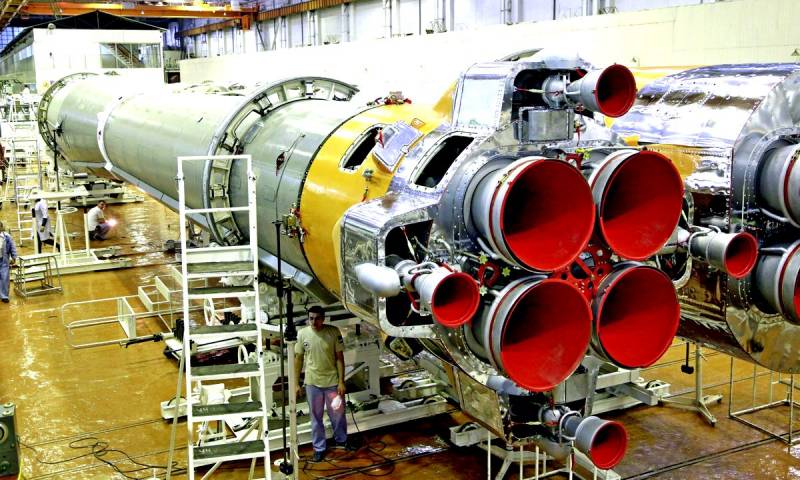Russia will help create a superheavy rocket
The priority directions in space exploration are the Moon and travel to Mars. To achieve them, spacecraft of a new generation are required.
Currently, in the United States of America, work is underway to create a superheavy rocket. NASA is developing the Space Launch System, which will be able to put payloads from 70 to 130 tons into orbit and launch the Orion manned spacecraft. The Agency is rivaled by the private company SpaceX, owned by billionaire Ilon Mask, which in February 2018 successfully launched an ultra-heavy rocket with the speaking name Falcon Heavy. The "heavy falcon" is capable of placing up to 64 tons of cargo into low Earth orbit, 27 tons into the geo-transition orbit, almost 17 tons today to Mars. Moreover, Musk announced the creation of a new project called Big Falcon Rocket (BFR), whose carrying capacity will be up to 150 tons, which will replace all smaller caliber missiles with it. BFR will be built immediately with an eye on the moon and Mars.
The activity of the Americans and their bluntly expressed plans for the militarization of the Earth’s satellite are forcing Russia and China to respond adequately. China is developing its own super-heavy rocket called Changzheng-9, which will launch into space up to 133 tons of payload. In the USSR, the Energia rocket was created, which was designed for a whole range of tasks: launching Buran, military cargo, orbital stations into orbit, and ensuring the implementation of the lunar and Martian missions. However, in the nineties, the Energy program was curtailed, missiles in Kazakhstan were destroyed by the “accidental” collapse of the roof of the building, and the Energia NPOs in Russia were cut and thrown into the backyard of the enterprise. Incidentally, the roof also fell "accidentally" onto the Buran, rendering it completely unusable.
In 2018, President Putin decided to create a new Russian superheavy rocket. It is expected that she will fly in 2028 from the Vostochny Cosmodrome in the Amur Region. When creating it, the first stage of the promising Soyuz-5 rocket, which is also in operation, should be used. Soyuz-5 will start from Baikonur, for which the cosmodrome will need major modernization at the expense of Kazakhstan. In this connection, the prospects for international cooperation opening up before Russia are interesting.
- stated in Kazkosmos.
It is obvious that Kazakhstan wants to become, with the help of the Russian Federation, a full-fledged space power. This is also indicated by the desire to create a production of components for space on Baikonur equipment, as well as its own light rocket, with which Astana will be able to provide services to launch small satellites. The question is how this cooperation will turn out in the long run for Russia.
Currently, in the United States of America, work is underway to create a superheavy rocket. NASA is developing the Space Launch System, which will be able to put payloads from 70 to 130 tons into orbit and launch the Orion manned spacecraft. The Agency is rivaled by the private company SpaceX, owned by billionaire Ilon Mask, which in February 2018 successfully launched an ultra-heavy rocket with the speaking name Falcon Heavy. The "heavy falcon" is capable of placing up to 64 tons of cargo into low Earth orbit, 27 tons into the geo-transition orbit, almost 17 tons today to Mars. Moreover, Musk announced the creation of a new project called Big Falcon Rocket (BFR), whose carrying capacity will be up to 150 tons, which will replace all smaller caliber missiles with it. BFR will be built immediately with an eye on the moon and Mars.
The activity of the Americans and their bluntly expressed plans for the militarization of the Earth’s satellite are forcing Russia and China to respond adequately. China is developing its own super-heavy rocket called Changzheng-9, which will launch into space up to 133 tons of payload. In the USSR, the Energia rocket was created, which was designed for a whole range of tasks: launching Buran, military cargo, orbital stations into orbit, and ensuring the implementation of the lunar and Martian missions. However, in the nineties, the Energy program was curtailed, missiles in Kazakhstan were destroyed by the “accidental” collapse of the roof of the building, and the Energia NPOs in Russia were cut and thrown into the backyard of the enterprise. Incidentally, the roof also fell "accidentally" onto the Buran, rendering it completely unusable.
In 2018, President Putin decided to create a new Russian superheavy rocket. It is expected that she will fly in 2028 from the Vostochny Cosmodrome in the Amur Region. When creating it, the first stage of the promising Soyuz-5 rocket, which is also in operation, should be used. Soyuz-5 will start from Baikonur, for which the cosmodrome will need major modernization at the expense of Kazakhstan. In this connection, the prospects for international cooperation opening up before Russia are interesting.
According to the approved concept of further cooperation at the Baikonur complex, the main directions of promising joint space projects of Kazakhstan and Russia are identified ... the creation of a superheavy space missile complex
- stated in Kazkosmos.
It is obvious that Kazakhstan wants to become, with the help of the Russian Federation, a full-fledged space power. This is also indicated by the desire to create a production of components for space on Baikonur equipment, as well as its own light rocket, with which Astana will be able to provide services to launch small satellites. The question is how this cooperation will turn out in the long run for Russia.

Information